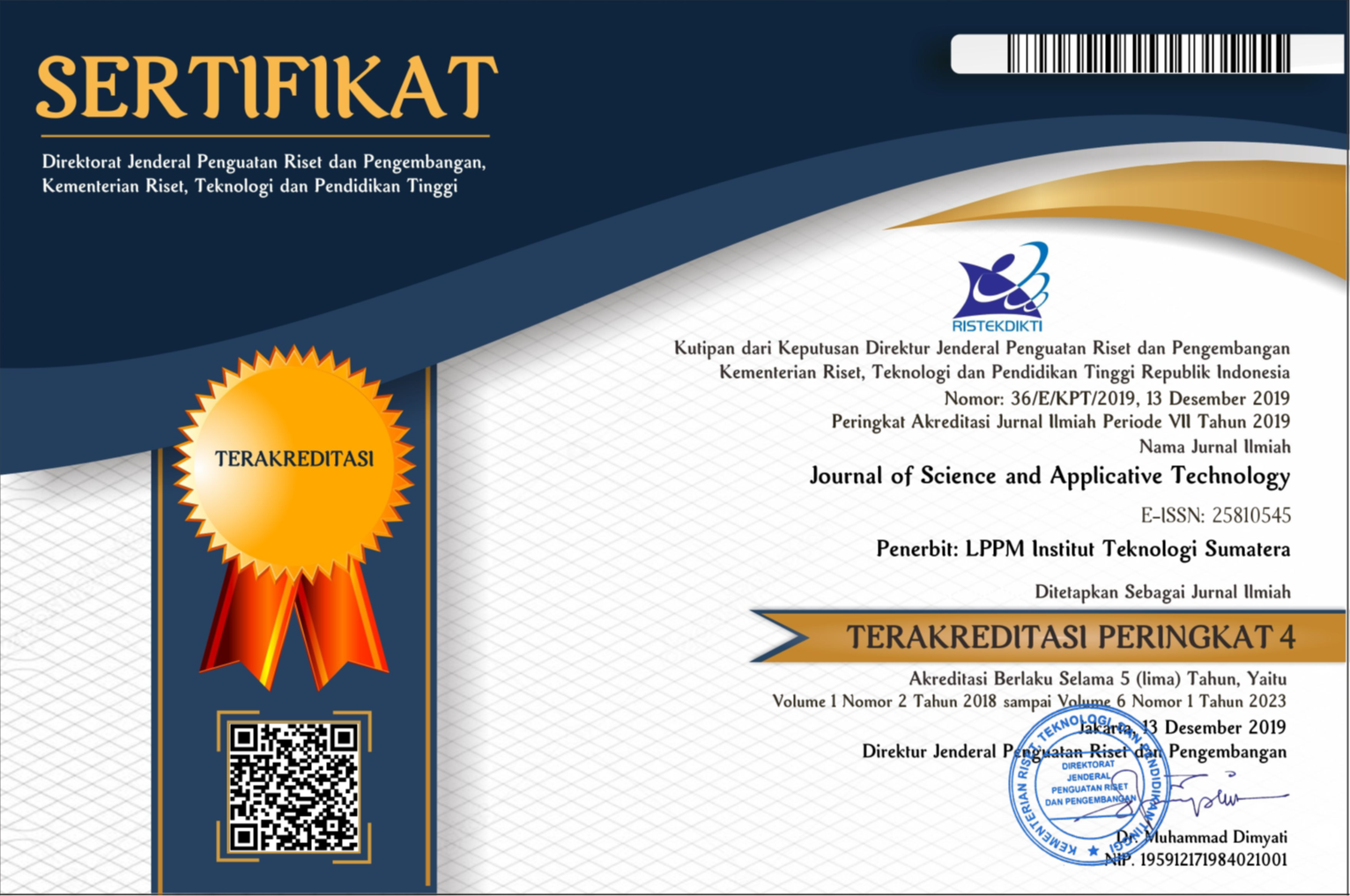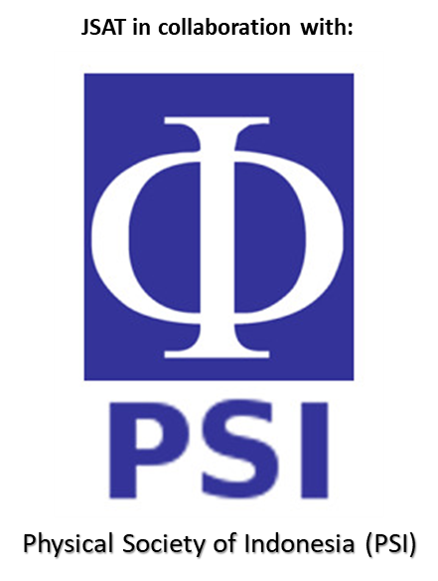SELULOSA NANOSERAT TANDAN SAWIT SEBAGAI MATRIKS FILM INDIKATOR ALAMI KESEGARAN PANGAN
Abstract
The food freshness is one trending topic that currently studied to reduce the number of food waste. The development of food freshness film indicator is one technique that can be utilized to resolve the high number of food waste. The objective of this study was to evaluate the ability of cellulose nanofiber film that had been integrated with anthocyanine as the food freshness film indicator. Cellulose nanofiber was obtained from empty fruit bunch of palm oil that had been dried, cut, and milled into fine powder. The initial step of this preparation was bleaching process using NaOCl/NH3 and H2O2/NH3. After bleaching process, cellulose fiber was oxidized using TEMPO/NaOCl/NaBr at pH 10 for 6 h. The TEMPO-oxidized cellulose fiber was then transferred into high pressure-homogenizer for 6-cycles at 800 bar of pressure. The cellulose nanofiber was obtained as hydrated fiber (gel-like) and then combined with anthocyanine obtaining from red cabbage extract, the film was casted on the acrylic plate. The film indicator of cellulose nanofiber was analyzed to determine the characteristic of film, i.e., color stability depending on pH, morphology, mechanical properties, and color response of film on the food freshness. The film of cellulose nanofiber that integrated with anthocyanin extract has the good sensitiveness to test the food freshness at 4oC. The color change produced by this indicator film is quite significant and has a different color at each pH value.
Downloads
References
[2] P. Ghisellini, C. Cialani, and S. Ulgiati, "A review on circular economy: the expected transition to a balanced interplay of environmental and economic systems," Journal of Cleaner Production, vol. 114, pp. 11-32, 2016.
[3] A. Jurgilevich et al., "Transition towards Circular Economy in the Food System," Sustainability, vol. 8, no. 1, p. 69, 2016.
[4] M. Moazami Goodarzi, M. Moradi, H. Tajik, M. Forough, P. Ezati, and B. Kuswandi, "Development of an easy-to-use colorimetric pH label with starch and carrot anthocyanins for milk shelf life assessment," International Journal of Biological Macromolecules, vol. 153, pp. 240-247, Jun 15 2020.
[5] B. Kuswandi and A. Nurfawaidi, "On-package dual sensors label based on pH indicators for real-time monitoring of beef freshness," Food Control, vol. 82, pp. 91-100, 2017.
[6] Y. Ge, Y. Li, Y. Bai, C. Yuan, C. Wu, and Y. Hu, "Intelligent gelatin/oxidized chitin nanocrystals nanocomposite films containing black rice bran anthocyanins for fish freshness monitorings," International Journal of Biological Macromolecules, vol. 155, pp. 1296-1306, Jul 15 2020.
[7] A. Chakrabarty and Y. Teramoto, "Recent Advances in Nanocellulose Composites with Polymers: A Guide for Choosing Partners and How to Incorporate Them," Polymers, vol. 10, no. 5, May 10 2018.
[8] F. Martoïa, P. J. J. Dumont, L. Orgéas, M. N. Belgacem, and J. L. Putaux, "On the origins of the elasticity of cellulose nanofiber nanocomposites and nanopapers: a micromechanical approach," RSC Advances, vol. 6, no. 53, pp. 47258-47271, 2016.
[9] I. P. Mahendra, B. Wirjosentono, Tamrin, H. Ismail, and J. A. Mendez, "Thermal and Morphology Properties of Cellulose Nanofiber from TEMPO-oxidized Lower part of Empty Fruit Bunches (LEFB)," Open Chemistry, vol. 17, no. 1, pp. 526-536, 2019.
[10] H. S. Yang, A. Kiziltas, and D. J. Gardner, "Thermal analysis and crystallinity study of cellulose nanofibril-filled polypropylene composites," Journal of Thermal Analysis and Calorimetry, vol. 113, no. 2, pp. 673-682, 2013.
[11] Z. Czibulya, I. Horváth, L. Kollár, and S. Kunsági-Máté, "Unexpected effect of potassium ions on the copigmentation in red wines," Food Research International, vol. 45, pp. 272-276, 2012.
[12] P. Sari, C. H. Wijaya, D. Sajuthi, and U. Supratman, "Colour properties, stability, and free radical scavenging activity of jambolan (Syzygium cumini) fruit anthocyanins in a beverage model system: Natural and copigmented anthocyanins," Food Chemistry, vol. 132, pp. 1908-1914, 2012.
[13] Y. Li, K. Wu, B. Wang, and X. Li, "Colorimetric indicator based on purple tomato anthocyanins and chitosan for application in intelligent packaging," International Journal of Biological Macromolecules, vol. 174, pp. 370-376, Mar 31 2021.
[14] M. Alizadeh-Sani et al., "pH-responsive color indicator films based on methylcellulose/chitosan nanofiber and barberry anthocyanins for real-time monitoring of meat freshness," International Journal of Biological Macromolecules, vol. 166, pp. 741-750, Jan 1 2021.
[15] J. Liu et al., "Improving the color stability and antioxidation activity of blueberry anthocyanins by enzymatic acylation with p-coumaric acid and caffeic acid," LWT - Food Science and Technology, vol. 130, 2020.
[16] E. M. Ahmed, "Hydrogel: Preparation, characterization, and applications: A review," Journal of advanced research, vol. 6, no. 2, pp. 105-21, 2015.
Copyright (c) 2023 Journal of Science and Applicative Technology

This work is licensed under a Creative Commons Attribution-NonCommercial 4.0 International License.
All the content on Journal of Science and Applicative Technology (JSAT) may be used under the terms of the Creative Commons Attribution-NonCommercial 4.0 International License.
You are free to:
- Share - copy and redistribute the material in any medium or format
- Adapt - remix, transform, and build upon the material
Under the following terms:
- Attribution - You must give appropriate credit, provide a link to the license, and indicate if changes were made. You may do so in any reasonable manner, but not in any way that suggests the licensor endorses you or your use.
- NonCommercial - You may not use the material for commercial purposes.
- No additional restrictions - You may not apply legal terms or technological measures that legally restrict others from doing anything the license permits.





















